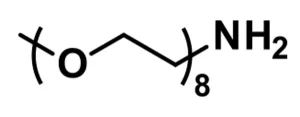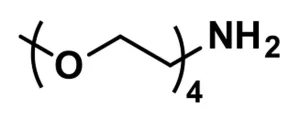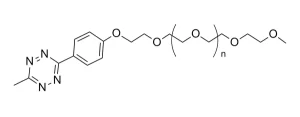m-dPEG®23-OH, product number QBD-10942, is a chemical modification reagent consisting of a long (70 atoms, 83.1 Å), methyl-terminated, water-soluble, non-immunogenic, single molecular weight, discrete polyethylene glycol (dPEG®) chain that terminates with a reactive primary alcohol (i.e., a hydroxy group). The hydroxy group can be functionalized with different groups that enable various types of reactions.
This product is comparable to mPEG1000, but it is a monodispersed PEG rather than a heterogeneous polymer PEG. Functionalization of the terminal alcohol with a variety of different groups permits this product to bring the benefits of dPEG® products to surfaces, small molecules, and biomolecules, including peptides, proteins, carbohydrates, and oligonucleotides. One useful application of this product is in coating surfaces to prevent non-specific or hydrophobic interactions. Other benefits that m-dPEG®23-OH brings to conjugated molecules include increased hydrodynamic volume (leading to reduced renal clearance), better water solubility, and reduced antigenicity.
| Unit Size | 100mg, 1000mg |
|---|---|
| Molecular Weight | 1045.25; single compound |
| Chemical formula | C₄₇H₉₆O₂₄ |
| CAS | 114740-40-8 |
| Purity | > 95% |
| Spacers | dPEG® Spacer is 70 atoms and 83.1 Å |
| Shipping | Ambient |
| Typical solubility properties (for additional information contact Customer Support) | Methylene chloride, Acetonitrile, DMAC, DMSO or water. |
| Storage and handling | -20°C; Always let come to room temperature before opening; be careful to limit exposure to moisture and restore under an inert atmosphere; stock solutions can be prepared with dry solvent and kept for several days (freeze when not in use). dPEG® pegylation compounds are generally hygroscopic and should be treated as such. This will be less noticeable with liquids, but the solids will become tacky and difficult to manipulate, if care is not taken to minimize air exposure. |
Greg T. Hermanson, Bioconjugate Techniques, 3rd Edition, Elsevier, Waltham, MA 02451, 2013, ISBN 978-0-12-382239-0; See Chapter 18, Discrete PEG Reagents, pp. 787-821, for a full overview of the dPEG® products.
Temperature-Responsive Self-Assembled Monolayers of Oligo(ethylene glycol): Control of Biomolecular Recognition .Hadi M. Zareie , Cyrille Boyer , Volga Bulmus , Ebrahim Nateghi and Thomas P. Davis. ACS Nano. 2008, 2 (4) pp 757-765. April 4, 2008. 10.1021/nn800076h
Sequential Nucleophilic Substitutions Permit Orthogonal Click Functionalization of Multicomponent PEG Brushes. Jin Sha, Ethan S. Lippmann, Jason McNulty, Yulu Ma, and Randolph S. Ashton. Biomacromolecules. 2013, 14 (9) pp 3294–3303. August 13, 2013. DOI: 10.1021/bm400900r.
Applicable patents and legal notices are available at legal notices.




Stay in the Loop. Join Our Online Community
Products
Ordering
About Us
Application
Resources

©Vector Laboratories, Inc. 2025 All Rights Reserved.
To provide the best experiences, we use technologies like cookies to store and/or access device information. Consenting to these technologies will allow us to process data such as browsing behavior or unique IDs on this site. Not consenting or withdrawing consent, may adversely affect certain features and functions. Privacy Statement
How do I Request a Quote?
To request a quote for products: